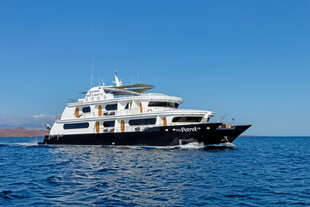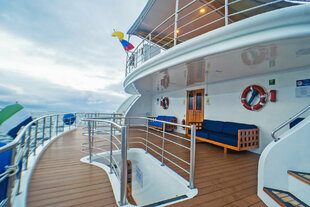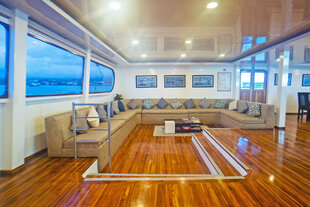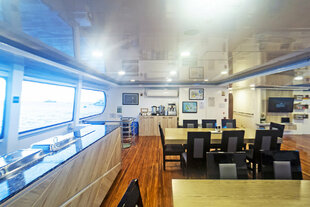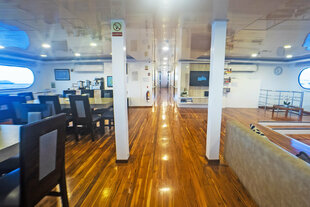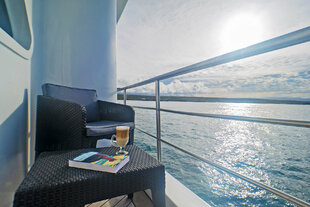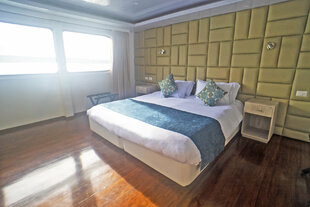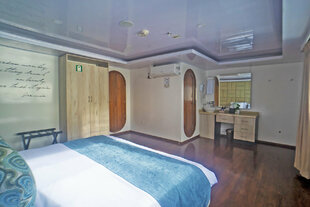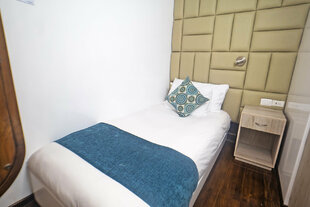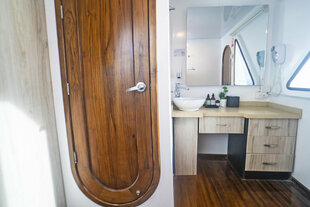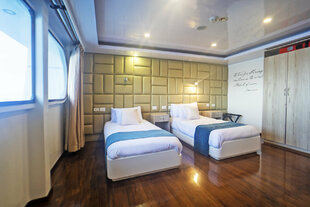Petrel is a modern Galapagos motor yacht which can accommodate up to 16 passengers in 9 spacious cabins. There are 2 suites on the main deck, each 463 ft2 / 43 m2 in area, as well as 2 double staterooms, each 323 ft2 / 30 m2. The upper deck holds a further 4 staterooms, which are each 312 ft2 / 28 m2 in size, and a single stateroom, 151 ft2 / 14 m2. All cabins are ensuite, with private balconies, modern interiors and feature murals.

Social areas are spacious and comfortable, including a lounge, a bar filled with local spirits as well as international favourites and signature cocktails and a hot tub. Aside from the interior dining room, there is also an al fresco dining area where open-air BBQs are sometimes held.
The chefs onboard will prepare each meal, serving local Ecuadorian and international cuisine throughout the cruise. Dietary requirements can be met, so make sure to let us know before you book if you need these to be met.
She offers 6 different itineraries, ranging from 4 to 8 days, all of which can be enjoyed separately or combined to facilitate deeper exploration of the Galapagos Islands.
Wildlife & Photography
The main focus of this trip is to experience the Galapagos’ unique wildlife and landscapes above, on and below the water. All itineraries include activities like hiking, kayaking, snorkelling, panga rides and swimming on excursions which take place twice daily, helping to give you the opportunity to explore the archipelago from different perspectives.
Each of the islands provides its own individual environment due to their age differences and stages of colonisation, which can differ by millions of years. As you make your way through any of the itineraries here, you will notice gradual changes in the landscapes and wildlife which you are surrounded by. Some of the wildlife which you can hope to see here includes Galapagos Sea Lions, Marine and Land Iguanas, Nazca and Blue-Footed Boobies, Galapagos Tortoises, Galapagos Penguins and Flightless Cormorants, among many others.
The great abundance and variety of life here makes this trip ideal for photographers. There are plenty of opportunities for every photographer to get their shots – macros of sunbathing Marine Iguanas, wide-angles of Sea Lion colonies and the islands and underwater captures of Sharks and Rays are just some of the possibilities here.
Even though the trips offered here explore a lot of the archipelago’s wonders, there are many other ways which you can explore the Galapagos Islands. If you wanted to extend your stay here to experience more of this location, you could book an add-on experience, such as a dive liveaboard from our Galapagos Dive Liveaboards page or one from our Galapagos page. We also offer trips in mainland Ecuador which you could choose to experience too.
Technical Specifications
| Constructed | September 2015 |
| Type | Power motor catamaran |
| Length | 115 ft / 35 m |
| Beam | 41 ft / 12.5 m |
| Draft | 5.4 ft / 1.65 m |
| Weight | 208 tons |
| Guest capacity | Maximum 16 |
| Cabins |
Main deck Upper deck |
| Engines | 2 × Yanmar diesel engines 490HP |
| Top speed | 10 knots |
| Exterior material | GFRP |
| Crew | 9 + captain, naturalist guide & cruise manager |
| Safety & navigation | 2 × 20-man life rafts, Navtex, 2 × GPSs, depth sounder, 2 × naval radars, fire detection & prevention systems |
Deck Plan
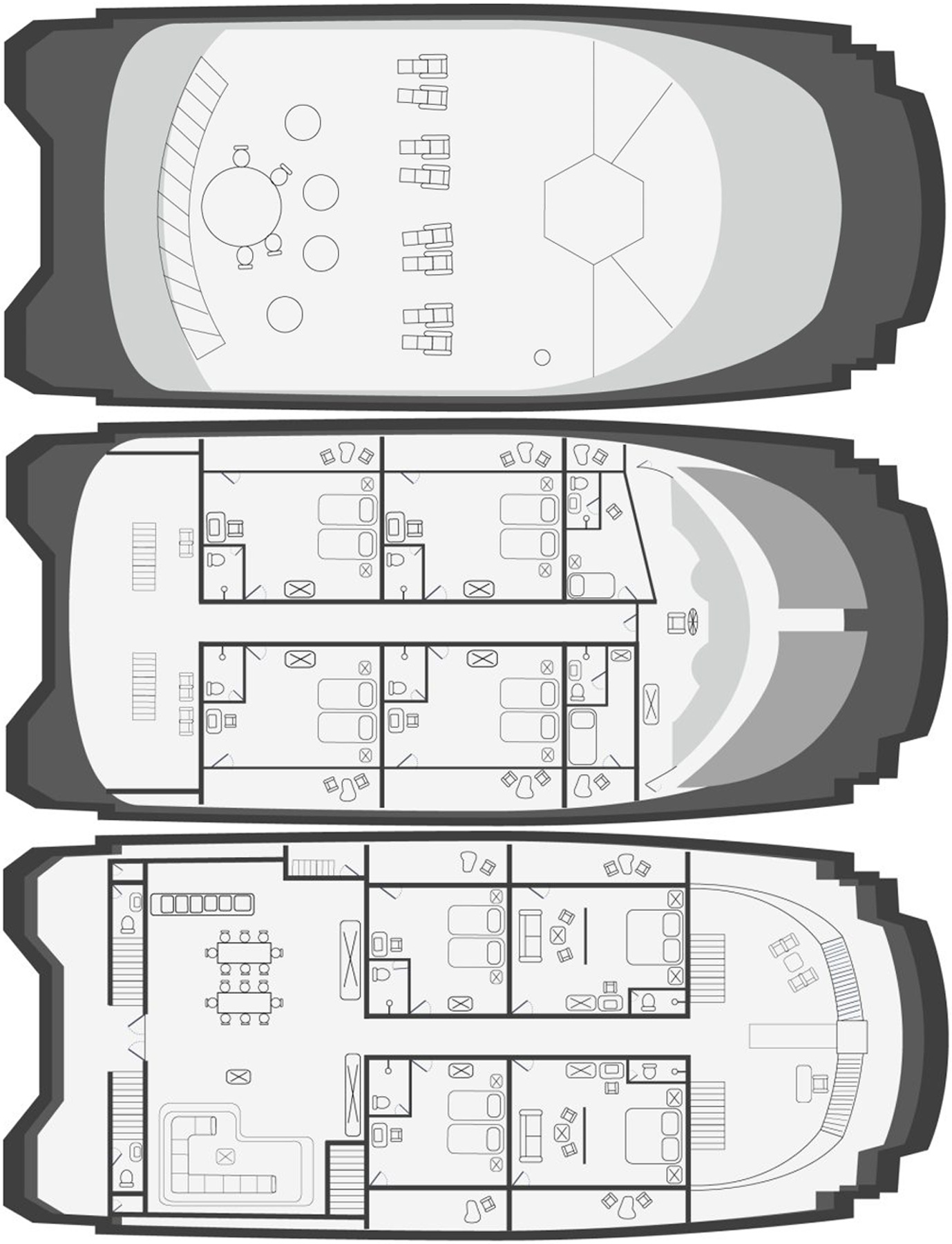
Itinerary
Please note that these itineraries are subject to change without notice due to seasonal changes, last minute weather conditions and the decision of the Galapagos National Park authority.
Itinerary A – Isabela, Fernandina & Central Islands (8 days / 7 nights)

Day 1 (Friday) – Arrival & North Seymour
AM: Arrival, Baltra Island
Upon arrival Baltra, travellers pass through an airport inspection point to make sure that no foreign plants or animals are introduced to the islands, and to pay the park entrance fee of $200 (unless it has been prepaid). A guide will meet you, help you collect your luggage and escort you on a short bus ride to the harbour.
PM: North Seymour Island
This islet is one of most visited sites in the Galapagos and it is teeming with birdlife. An easy circular path takes you through the archipelago’s most extensive colonies of blue-footed boobies and frigate birds. At the beginning of the breeding season, adult frigatebird-males blow up their vivid red pouches (gulas) to impressive football-sized balloons. This is one of the few spots where you can compare the magnificent and the great frigatebird breeding next to each other.
You are likely to come across several land iguanas on North Seymour and the coast can be a good place to spot Galapagos sealions.
Day 2 (Saturday) – Vicente Roca Point & Espinosa Point
AM: Punta Vicente Roca, Isabela Island
There are great snorkelling opportunities at Vicente Roca Point thanks to upwelling cold-water currents here. Marine life in the area includes various Shark species, Galapagos Penguins, Seahorses & Mola-Mola. Other animals which you can hope to see here are Nazca & Blue-Footed Boobies, Brown Pelicans & Flightless Cormorants.
PM: Punta Espinoza, Fernandina Island
Fernandina is the third largest island in the archipelago and has a single visitor site: Punta Espinoza, located at the northeastern tip of the island. Here, marine iguanas conglomerate in larger groups than on any other island. They bask around in the sand, swim near the shore and sometimes block the way at the landing dock. Among the unique species found here, we can find the flightless cormorant.
Day 3 (Sunday) – Tagus Cove & Urbina Bay
AM: Tagus Cove, Isabela Island
A tour along the cliffs will give visitors a good chance to see the Galapagos penguin, the flightless cormorant and other seabirds. From the landing dock, it is about a 30-minute hike along the trail up to the top of the cliff from where you can view Darwin Lake, an uplifted lake saltier than the sea. You can also see several volcanoes from this location. Look carefully at the graffiti on the surrounding cliffs of the cove, done by pirates, whalers and buccaneers in past centuries!
PM: Urbina Bay, Isabela Island
Urbina Bay is on the west coast of Isabela and has a recently uplifted seabed which has forced corals up above the water’s surface, providing a unique snorkelling experience. There are 2 treks at this bay which offer chances of seeing Galapagos Tortoises & large Land Iguanas amongst other wildlife including Flycatchers, Finches & Mockingbirds.
Day 4 (Monday) – Elizabeth Bay & Moreno Point
AM: Elizabeth Bay, Isabela Island
This is a marine visitor site, so the excursion has no landing point. Your panga ride starts with a visit to the Marielas islets: home to the largest and most important penguin colony in the Galapagos Islands. The excursion continues into a cove, surrounded by red mangroves, where you can admire their red roots and green leaves. Here, you might be able to observe sea turtles, flightless cormorants, spotted eagle rays, golden cownose rays, brown pelicans and sealions. You might also see Galapagos hawks soaring overhead with schools of pompano and dorado fish swimming down below.
PM: Punta Moreno, Isabela Island
Moreno Point is located on the north coast of Isabela Island between the volcanoes Sierra Negra and Cerro Azul. The trail runs along a solid dry lava flow called Pahoehoe into a complex of lagoons. Its main attraction are birds, which are found around the lakes and mangroves.
Day 5 (Tuesday) – Sierra Negra & Arnaldo Tupiza Centre / Wetlands
AM: Sierra Negra Volcano, Isabela Island
Of volcanic scenery, southern Isabela is home to a volcanic crater second only in scale to Tanzania's Ngorongoro Crater. Volcan Sierra Negra is 6 miles (10 km) across! To reach the closest point of the crater edge involves an overland drive and then a between 45 mins to 1 ½ hour hill walk. On a dry sunny day this can be relatively easy. When cloud comes in and there is rain, we have to pick our way more carefully. The summit can often be seen from the southern coast, but on days when cloud obscures a view, we can trek above this layer for clear views across the crater – if not at first then certainly as we trek east along the crater edge where the climate is drier. When you reach the crater edge, the scale of the landscape is difficult to absorb.
The ultimate aim is to trek along the crater edge to Cerro Chico. This parasitic cone erupted spectacularly in 2005, just when the BBC were filming a series called Islands that Changed the World. Just beneath the surface, the rocks can be very hot, with lava tunnels running in all directions. It is essential to stick to marked trails here, because apparently solid rock can be very thin, with large voids beneath. The stark scenery here is a beautiful mix of shades and contrast between vegetation and bare dried contorted lava. Views from Cerro Chico extend far north to the enormous Elizabeth Bay and Fernandina Island.
PM: Arnaldo Tupiza Breeding Centre & Wetlands, Isabela Island
In the Arnaldo Tupiza Tortoise Breeding Centre you can see hundreds of giant Galapagos tortoises of all sizes. Vulnerable hatchlings are not gigantic at all, even smaller than the size of your hand! This project just outside Puerto Villamil was created to rescue the endangered populations of Isabela’s two southern volcanoes. From the almost incredible estimations of 250,000 giant tortoises in the 16th Century, by the 1970s there were only about 3,000 individuals remaining. One thing becomes clear on your visit: it’s hard work to save these creatures from extinction by reproduction in captivity and repopulation. The good news is that these programmes are successful and have already saved several species from extinction. By 2015 tortoise numbers across the Galapagos increased to about 32,000.
Don’t forget to visit the native botanical garden of this breeding centre. It also attracts colourful songbirds such as yellow warblers, Darwin’s finches, Galapagos and vermillion flycatchers.
Leading from the Centre to the western beaches of Puerto Villamil is a woodland trail and boardwalk through a series of saline lagoons. This can be a good place to see graceful American flamingos, filtering the saline water for shrimp and algae. They are joined by a handful of species of aquatic and shore birds; as well as marine iguanas as you approach the trail where it meets the sea.
Day 6 (Wednesday) – Darwin Station & Highlands
AM: Charles Darwin Research Station, Santa Cruz Island
Although the great majority of Galapagos visitors come here to observe and appreciate natural wonders, it is also interesting to learn how the protection and conservation of the islands are carried out. The main attractions are the National Park information centre, the Van Staelen Exhibition Hall, the Breeding and Rearing Centre for young tortoises, and adult Galapagos tortoises in captivity.
PM: Highlands, Santa Cruz Island
The road to the highlands leaves from Bellavista, a small village located a 15-minute drive from Santa Cruz’ main town of Puerto Ayora. The road passes through the Galapagos’ most productive agricultural zone, up to the National Park boundary. We find Miconia vegetation at this altitude, changing to the Fern and Sedge zone as we ascend further. With clear weather, we can enjoy beautiful scenes of rolling hills and extinct volcanic cones covered with grass and lush greenery all year round. In the Highlands is El Chato Reserve, where Giant Galapagos Tortoises can be observed in the wild – the iconic species which gave the Galapagos Islands their name. Other species to see at this reserve include Short-Eared Owls, Yellow Warblers & Finches. More elusive species which can be difficult to spot here are Galapagos Rails & Paint-Billed Crakes.
Day 7 (Thursday) – South Plaza & Santa Fé
AM: South Plaza Island
South Plaza is a beautiful island formed out of lava which bubbled up to the sea surface. It is relatively small but very diverse in its botany and very good for spotting Land Iguanas. hybrid Iguanas exist here, created through the mating of male marine iguanas and female land iguanas.
There are approximately 1,000 Galapagos Sealions on the island and birdlife is plentiful. Cliffs on the western side are nesting sites for Blue-footed and Nazca Boobies, whilst we can find Darwin's Finches amongst the rocks of the eastern side, Lava Gulls and lovely Swallow-tail Gulls. Red-billed Tropicbirds often swoop low overhead, whilst in the sea beneath the western cliffs we can often see schools of fish close to the surface.
This island can be one of the best for photography.
PM: Santa Fé Island
uplift rather than being from a volcanic origin, which is why it is mostly flat. There are some theories claiming that this could be the oldest island in the archipelago. Santa Fé is home to a number of endemic species like the Galapagos Hawk, Galapagos snake, Galapagos mockingbird, rice rats and one of the two species of land iguanas on the islands. After disembarking into the beautiful and clear waters, you will be in contact with one of the many sea lion colonies. Along the trail, many saltbushes can be seen, as well some particularly impressive giant Opuntia cacti ‘trees’.
The island is some 24 km2 in area and a maximum 60 metres above sea level. The waters which surround it can be a lovely turquoise blue, with a protective barrier of rocks creating a semi-lagoon which is ideal for humans and sealions alike for swimming and snorkelling.
Day 8 (Friday) – Lobos & Departure
AM: Isla Lobos, San Cristobal
The Lobos Islet’s beach harbours a colony of Galapagos sea lions. As in other colonies in the archipelago, you can approach nurturing females within a few metres. In the breeding season this colony is also visited by territorial males, defending and mating the harem on their section of beach. This low islet is home to more than just Galapagos sea lions. Two other emblematic species breed here: male blue-footed boobies and great frigate birds. In season, booby males try to impress females with clumsy dances, showing off how blue (and healthy) their feet are. Male frigatebirds inflate and wobble huge red throat poaches called gulas. Young fluffy offspring cry for food, whilst juveniles try out their wings ready to fly.
PM: Departure, San Cristobal Island
Your guide and some crew members will accompany you back to San Cristobal where you will take the airport shuttle. Your guide will remain with you through check-in counters & the departure hall.
Itinerary B – Española, Genovesa & Central Islands (8 days / 7 nights)
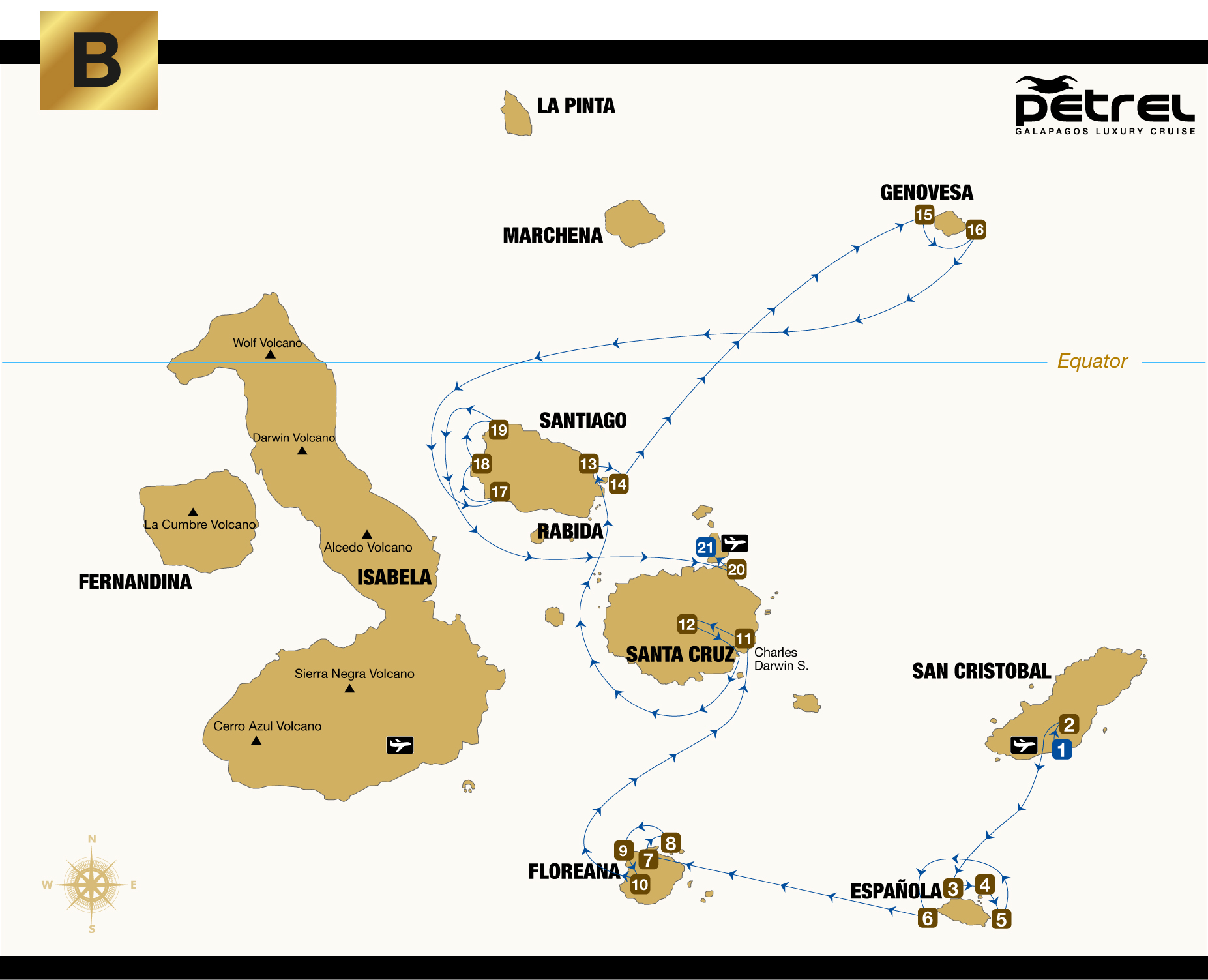
Day 1 (Friday) – Arrival & David Rodriguez Centre
AM: Arrival, San Cristobal Island
Land at San Cristobal airport where you will be directed towards the airport terminal building. You will need to queue here to pay your Galapagos National Park fee and have your luggage inspected for potential contaminants to the island, such as plant matter or seeds.
Please wait for you baggage to be unloaded. Collect it and then look for someone holding a card with your name or the name of your Galapagos yacht: Petrel.
PM: David Rodriguez Tortoise Breeding Centre, San Cristobal Island
Cerro Colorado Tortoises Protection and Growing Centre, located approximately 40 minutes by bus from the southeast of the island, was built to improve the status of the population of the island tortoises. The centre includes a large corral, a Visitor Centre, breeding centre and an interpretative trail. Along this trail, it is possible to see different species of native and endemic plants as well as birds like the San Cristóbal mockingbird, yellow warblers, many species of finches and the Galapagos flycatcher.
Day 2 (Saturday) – Gardner Bay / Osborn Islet / Gardner Islet & Suarez Point
AM: Gardner Bay, Osborn Islet & Gardner Islet, Española Island
The striking white beach at Gardner Bay is an important breeding site for Pacific green turtles. However, without doubt its main attraction is the Galapagos sea lion colony. Females stay year-round in this nursery, suckling their pups up to an age of 3 years, although they start to fish after 5 months of their birth. During the breeding and mating season, the colony becomes even bigger.
Gardner Islet is just off the coast of Española and is a great snorkelling site for a wide range of marine life. Some of the main creatures you can hope to see as you snorkel or kayak here include Galapagos Sea Lions, Eels, Pufferfish and Starfish.
Osborn Islet is just southeast of Gardner Bay where a similar snorkelling quality to Gardner Islet can be expected. You will be able to see Parrotfish, Sea Lions, Butterfly Fish and more.
PM: Punta Suarez, Española Island
Huge ocean waves crash onto the southern basaltic cliffs of Suarez Point, forming a spectacular blowhole. where the water sprays metres high into the air (depending on the season, the tide and how strongly the sea breeze pushes the waves). This location is home to the only breeding colony of Waved Albatross in the Galapagos. You can also see wildlife such as marine iguanas, Nazca and Blue-Footed Boobies. Take your time for a meditative break in silence at this emblematic viewpoint and convert this unforgettable moment in a lifetime experience.
Day 3 (Sunday) – Devil’s Crown / Cormorant Point & Post Office Bay / Baroness Lookout
AM: Devil’s Crown or Punta Cormorant, Floreana Island
Devil’s Crown is a small outcrop of rocks off the coast of Floreana near Cormorant Point with a circular arrangement which gives them their name. Here, there is spectacular snorkelling with an abundance of reef fish such as Parrotfish, Surgeonfish & King Angelfish as well as Sharks, Manta Rays & Hammerhead Sharks.
The peninsula of Punta Cormorant (Cormorant Point) marks the extreme northern cape of Floreana – an island formed from smaller volcanic cones, covered now by tropical dry forest (palo santo). At the landing beach, you are likely to be welcomed by a small colony of Galapagos sealions. The green sand on this beach contains a high percentage of glassy olivine crystals which have been blown out by the surrounding tuff cones.
The ‘flour sand’ beach on the southern side of the peninsula is made up of white coral ground into sand by Parrotfish. It feels very smooth on the feet. You may be able to spot stingrays who use the sandy bottom to bury themselves. During the first months of the year, Pacific green turtles come ashore to dig a nest in which to bury their eggs.
PM: Post Office Bay or Baroness Lookout, Floreana Island
Post Office Bay is primarily of cultural significance. In times before there was a reliable postal service, a barrel onshore was a point where British 16th century whalers and poachers could post a letter. You are encouraged to write and address one or two post cards; whilst at the same time picking out any which are addressed close to your home, which you are happy to hand deliver when you return.
Shallow waters offshore are lovely to swim in. If you doon a mask and snorkel, you might see Pacific green turtles which often graze here.
Baroness Lookout is a tuff in Floreana close to Post Office Bay. There are great Mangrove Forests here and a beautiful coastline where you can hope to have great marine life encounters with Sea Lions, Turtles & possibly Galapagos Penguins.
Day 4 (Monday) – Darwin Station & Highlands
AM: Charles Darwin Research Station, Santa Cruz Island
Although the great majority of Galapagos visitors come to the Charles Darwin Research Station to observe and appreciate natural wonders, it is also interesting to learn how the protection and conservation of the islands are carried out. The main attractions are the National Park information centre, the Van Staelen Exhibition Hall, the Breeding and Rearing Centre for young tortoises, and adult Galapagos tortoises in captivity.
PM: Highlands, Santa Cruz Island
The road to the highlands leaves from Bellavista, a small village located a 15-minute drive from Santa Cruz’ main town of Puerto Ayora. The road passes through the Galapagos’ most productive agricultural zone, up to the National Park boundary. We find Miconia vegetation at this altitude, changing to the Fern and Sedge zone as we ascend further. With clear weather, we can enjoy beautiful scenes of rolling hills and extinct volcanic cones covered with grass and lush greenery all year round. In the Highlands is El Chato Reserve, where Giant Galapagos Tortoises can be observed in the wild – the iconic species which gave the Galapagos Islands their name. Other species to see at this reserve include Short-Eared Owls, Yellow Warblers & Finches. More elusive species which can be difficult to spot here are Galapagos Rails & Paint-Billed Crakes.
Day 5 (Tuesday) – Sullivan Bay & Pinnacle Rock
AM: Sullivan Bay, Santiago Island
Setting foot at the lava stream covering Sullivan Bay is like landing on the moon. The desolate, stretched out lava fields seem mostly lifeless, but there is plenty to see on this highly popular site, with lots to photograph. Pacific green turtles seasonally bury eggs in the tiny white sand beach, where you might also encounter crabs, a stray blue heron or an American oystercatcher. On the lava flows sparse pioneer vegetation such as lava cacti and carpetweed are able to grow. You might also encounter a lava lizard, locusts or a small species of snake called the Galapagos racer.
PM: Pinnacle Rock, Bartolomé Island
Pinnacle rock is a volcanic plug, an island which was created in the vent of a volcano. Although now largely eroded, Pinnacle Rock is home to many unique species of liken and houses a Galapagos Penguin colony at the foot of the rock.
Day 6 (Wednesday) – Darwin Bay & Prince Philip’s Steps
AM: Darwin Bay, Genovesa Island
Inside the submerged caldera of Genovesa lies Darwin Bay, whose diameter is more than 1.5 km (1 mile) and it is almost 200 m (650 ft) deep. The small area will surprise you repeatedly, walking along a coral sand beach, crossing barren lava formations and creeks, passing tidal pools, shrubs and further ahead following the top of some cliffs. With this peaceful surrounding, every species has occupied its own ecological niche (or habitat) without disturbing others. There is great birdlife here with starring species including Red-Footed Boobies, Great Frigatebirds & Laval Gulls. These often share the beach with Galapagos Sea Lions.
PM: El Barranco, Genovesa Island
Before landing, you will take an inflatable dinghy-ride along the eastern arm of the caldera. As we approach, the soaring 25 m / 80 ft high walls become overwhelming. Sometimes, a Galapagos fur seal is resting or a seabird is nesting on one of the ledges at the base. You will then have to hike and overcome the steep stairs from the landing dock to a bush of palo santo shrubs on top. Red-footed boobies gratefully use these scarce nesting places so that they don’t have to nest on the rocky ground. Upon arriving at the edge of the rim, the bushes open up and you can enjoy panoramic views, a sea breeze and the amazing flying skills of countless seabirds. Following the exposed rim, you will first pass a place where we usually encounter a colony of Nazca boobies; and finally reach the extensive storm petrel nesting places. If you are lucky, you can spot the well camouflaged short-eared owl hunting for them on foot!
Day 7 (Thursday) – Egas Port & Buccaneer Cove / Espumilla Beach
AM: Puerto Egas, Santiago Island
Puerto Egas is a black beach located at the west side of Santiago Island. Volcanic tuff deposits formed this special black sand beach and made it the main attraction of the Island. This site is called Puerto Egas because Hector Egas attempted to exploit the salt, which failed because the price of salt on mainland South America was too low to make it a viable export. There is a trail which follows the coastline here for sightings of Marine Iguanas, Galapagos Sea Lions and many sea birds. Land Iguanas were reintroduced to the island as recently as 2019, so look out for these as you walk. At the end of the trail is a small Galapagos Fur Seal colony. If you snorkel from the beach here, you may be able to see Turtles, a range of Fish and Reef Sharks.
PM: Buccaneer Cove or Espumilla Beach
Espumilla Beach is an important breeding site for turtles. It suffered for a period, from feral pigs which dug up turtle nests; but the beach’ natural state has been restored so the turtles return year after year to bury their eggs into the cinnamon-coloured sand dunes. 6 weeks later, during the months of February to August, the eggs hatch.
The beach ridge hides a mangle with two lagoons on the backside. A colony of American flamingos and aquatic birds used to be its main attraction, but after a previous El Niño, strong sedimentation altered the water environment, and now no longer provides their food. Vegetation zones are very close by, providing great scenic contrasts. During the climb up a hill, you will be rewarded with a beautiful view of the transitions from sea to beach and from mangrove to a dry palo santo forest.
You will alternatively visit Buccaneer Cove where you will have the opportunity to snorkel amongst Galapagos marine life.
Day 8 (Friday) – Black Turtle Cove & Departure
AM: Caleta Tortuga Negra, Santa Cruz Island
Black Turtle Cove offers engineless activities, so you will explore it by dinghy, paddling across the mangrove forested coastline of this stretch of Santa Cruz. There is great wildlife here due to the high levels of protection of this environment such as Sea Turtles, Pelicans & Sharks.
PM: Departure, Baltra Island
Your guide & some crew members will go with you to Baltra where you will board the airport shuttle. Your guide will remain with you through the check-in counters & departure hall.
Dates
Rates subject to change in case of additional taxes, fuel price increases or other unseen circumstances.
Our prices exclude
Round trip to Galapagos
Galapagos National Park entrance fee ($200)
Transit Control Card ($20)
Alcoholic & bottled drinks
Gratuities for guide & crew
Travel & health insurance
Our prices include
Transfers in the Galapagos (between airport and boat)
Airport reception & assistance
Accommodation onboard
Guided expeditions in itinerary
Galapagos National Park guide
All meals & snacks
Soft drinks & juices
Kayaks & paddleboards
Snorkelling equipment (mask, snorkel, fins & wetsuit)
Water containers
Single Supplement
For single cabin occupancy, there is a 50% increase in cabin price from the original per person cabin price (please call to check).

